Fortunate Fate
Fortunate fate brought me to the Rheinland-Pfalz region of Germany – from my dear home in Denver, Colorado, USA -to work and live for one year. Soon after arriving in Baumholder in December, I bought muck boots at the Baumarkt hardware store then began striking out from the edge of town, stomping around the countryside.
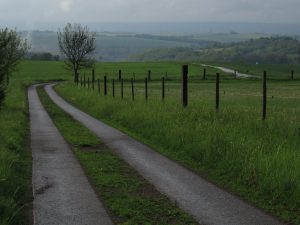
I discovered one-lane paved country roads with few cars, lots of cows, photogenic pastoral scenes and blicks – viewpoints overlooking the forested valleys.
… Began to see the rolling hills, the diverse, well-managed forests, the treeless hilltop moors – the high meadows, fields and pastures, ancient worn-down hills.
… Began to hear the silence and to resonate to the hum of the windmills’ whirling antic blades. A landscape gentle, a subtle delight for all the senses – natural beauty gently-manicured, a working land of tiny hamlets, farms, well-conserved forests and high, open moorlands.
“I have dropped into the very place I have been seeking.”
~ Isabella Bird (the first woman to climb Pikes Peak)
The Mission of acrosstherollinghills.net
– is to guide people exploring the German countryside by bicycle, walking, driving and family/friends activities. This guide focuses on the Nahe River Valley region of Rheinland-Pfalz, in west-central Deutschland. The guide will feature bike rides in the area, but will also include walking trails, family activities and points of interest in this serene and beautiful countryside.
Beyond Germany’s “Must-Sees”
Visitors to Germany arrive with a long list of ‘must-sees,’ and leave wondrously wowed by the world-class sights, foods, beverages, historic cities and castles. These visitors do go home fat and happy. Tourists see Famous Germany, but often miss the serene beauty of the quiet back-roads and rural rhythms of life out among the villages, forests and farms.
Those of us fortunate enough to live in Germany for any amount of time revel in the abundance of non-famous – but fascinating places we discover. Known mainly to locals, they are rarely visited by non-German visitors. No souvenir shops out here, no painstakingly reconstructed historical zones.
Discovering the Nordpfalzer Bergland
This land is as it has been for long centuries – the green and gentle hills, the mossy forests, the hay-fields, the house-barns, the creeks and seeps – here is the land – manicured after hundreds of years of kind human care and wise use. Life here reflects and honors thousands of years of agricultural life in rural Europa.
Rheinland-Pfalz is one of 16 states in in west-central Deutschland, near the French border with Alsace. In the eastern range of the state, the mighty Rhein River flows through the largest viticulture region in Germany. Here in the western reaches, called the Nordpfälzer Bergland – the North Palatinate Forest – rolling hills, deep river valleys, forests, pastures & cropland. Along the many creeks are tidy farming villages full of ancient wohnstallhaus – house-barns, home and barn under one roof.
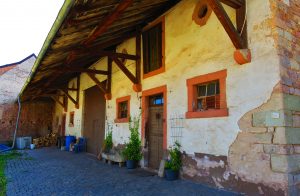
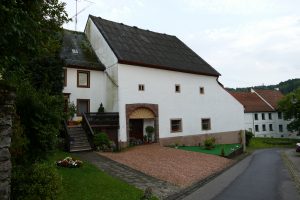
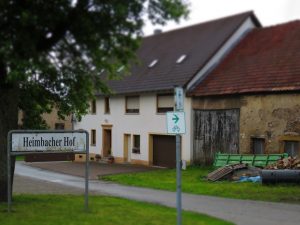
The farms are thriving family farms. Although this is one of the less-populated regions of Germany, the region does have cities, including Kaiserslautern (with a large English-speaking population) and Trier.
Driving the country roads during the too-cold-to-ride months of winter, I began exploring and photographing these villages, learning their odd-to-me names. Just within 30km of Baumholder, hidden in wooded, narrow valleys stand Mettweiler, Besrchweiler, Eckersweiler, Eitsweiler, Elzweiler, Asweiler, Hinsweiler, Gonnesweiler, Reichweiler, Ruthweiler, Hahnweiler, Fohren-Linden, Bedesbach, Erdesbach, Reichenbach, Heimbach and Heimbachof, Ruschberg and Thallichtenberg, Nohen and Nofelden, Eschelbacherof, Breitsesterhof and Zinkweilerhof, Neideralban and Oberalden, and (my favorite whimsical German town name) Pfeffelbach. And let us not forget Unterjeckenbach. I’ll stop myself here. I enjoyed stretching my neurons as I visualized these towns and the landscape. (weiler = hamlet; hof = farmstead, often a tiny hamlet of several homes, barns and outbuildings.)
Found a map of designated bike trails and another with hiking trails from the Nahe Tourist Association and began to explore the designated bicycling trails, the radwegs. Some stretches are paved one-lane country roads and can be explored and photographed by driving. There are some bicycle/walking/ running-only sections. The impressive, well-signed, nationwide system of designated bicycle routes feature standardized signage. I learned to watch for and follow the well-done bicycle route signs and made a list of rides to do once Spring done sprung.
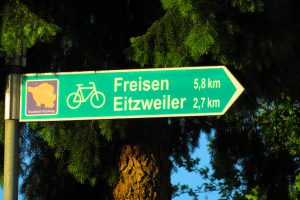
With the harbingers of Spring – warmer temps and lengthening days, I found a bike at the local bike shop, B-Line in Baumholder. The delightful lightly-used lightweight Cannondale ‘hybrid’ bike, a perfect bike for this terrain (between a mountain bike and a town bike). Named my bike Quelle – the source, as in the source of my joy.
My rides commenced, starting with the countryside near Baumholder, my one-year home. It is hilly, but the hills are neither long nor steep. Pushing the bike uphill, cruising gravity on the other side, ah yes – always puts a smile on this sun-weathered face! Glory to the day! The routes here are mostly one-lane well-paved roads, some dirt & gravel roads, some fun single-track and some grass sections. As spring stretched to summer, I couldn’t wait to get out onto the trails for a nice long ride after work, preferably at sunset – and the hills magically became less long – and less steep!
Made a list of trails to ride in Winter, explored the routes in the Spring, then rode the routes over the summer, continuing to search maps for new discoveries; My list was the seed for this Guide.
Bicycling the Nahe Region of Rheinland-Pfalz, Germany
Villages are in the narrow valley bottoms, along a creek or river; each creek has a hamlet. Riding out from the center of town on the curving, narrow streets, past the wohnstallhaus, well-tended flower gardens, well-swept gutters. The edge of the village is abrupt, forest and meadows appear suddenly, the idyllic countryside invites us in. The road climbs gently, but steadily, up a gully, across a hillside, through stands of mixed conifer and deciduous forests, alternating with pasturelands. Soon, the trail emerges from the hochwald, the high forest, and on up onto the broad rolling highland hills and ridges, the hochmoor.
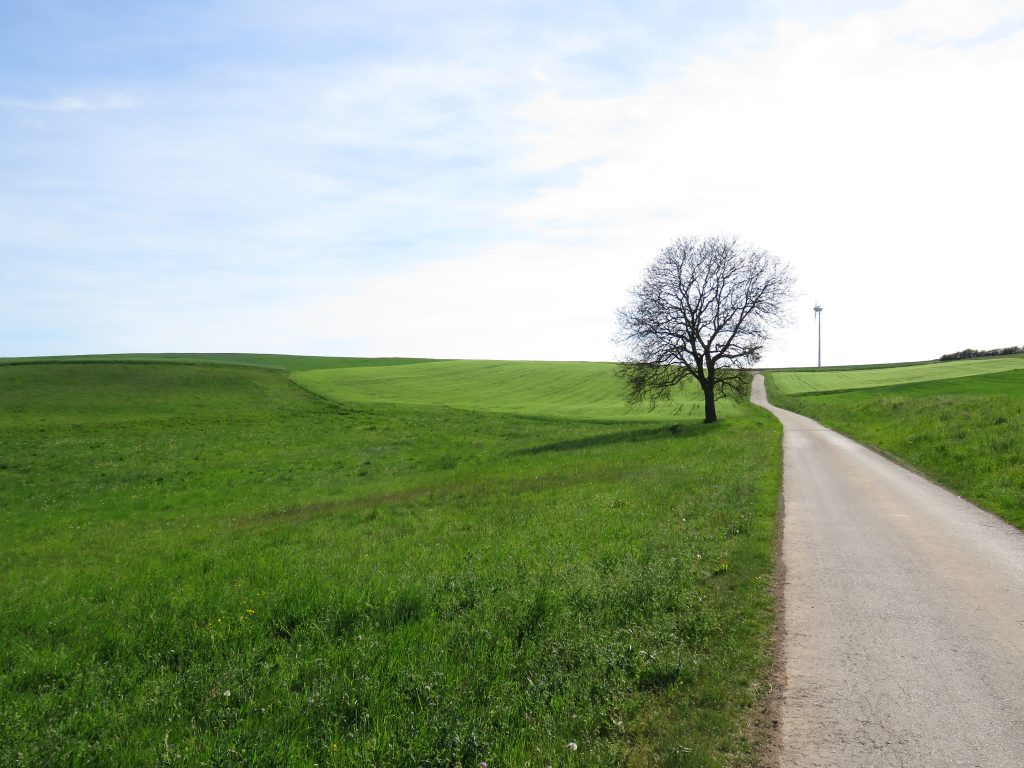
Most of the hilltops are treeless grasslands, meadows, hayfields and cropland. Below, the forests descend the steep valley slopes. From the hilltops, rolling hills and ridges fill the view in all directions, cut by deep river and creek drainages.
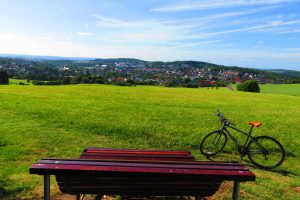
Blicks (viewpoints, usually with a lounge-chair-for-2-shaped park bench) feature the view north and west over the Nahe River Valley and on up to the horizon-filling ridge of dark forest, the Nationalpark Hunstrűck Hochwald. The humid air splits the dusk light into vivid hues and shades at sunset.
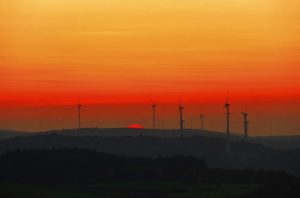
During the year that I have lived in Baumholder and discovered, then explored, then treasured, these biking and hiking routes, I gradually realized this spectacular, uncrowded bicycle-friendly area – the Nahe River Region and environs – is virtually unknown to bicyclists from outside the area.
Each year bicyclists from around the world come to ride the Rhein and Mosel River trails. Some ride hundreds of miles and enjoy their scenic ride and evenings in quaint wine villages and overnights in historic inns; these celebrated river rides deserve their fame.
If you live in the Rheinland-Pfalz region – or wish to experience time-honored rhythms of rural Germany– this guide is for you! Explore by bike or foot and have time to absorb this world – and discover a Germany few non-locals see.
We Will Explore
We will explore the radwegs of lesser-known rivers south and west of the Rhein and Mosel with a few other goodies thrown in for fun. We explore the finest rides on the Nahe River Radweg between the Nahequelle (source) and its mouth on the Rhein River. Don’t worry, we’ll stop for bier and eis (gelato) and do the 128 km in sections! We’ll ride the riverside of the Saar River around a huge horseshoe curve, then hike up the valley to view the whole curve from a blick far above. The Glan River Radweg follows the bed of a former railroad for 40 km through picture-book villages, past old mills and stately village kirsches. We will ride the rail on a human/bicycle-powered handcar. We will ride the official designated ragweg routes, including the Rheinland-Pfalz Radweg, the Bergen Radweg and my favorite, the Seeradweg.
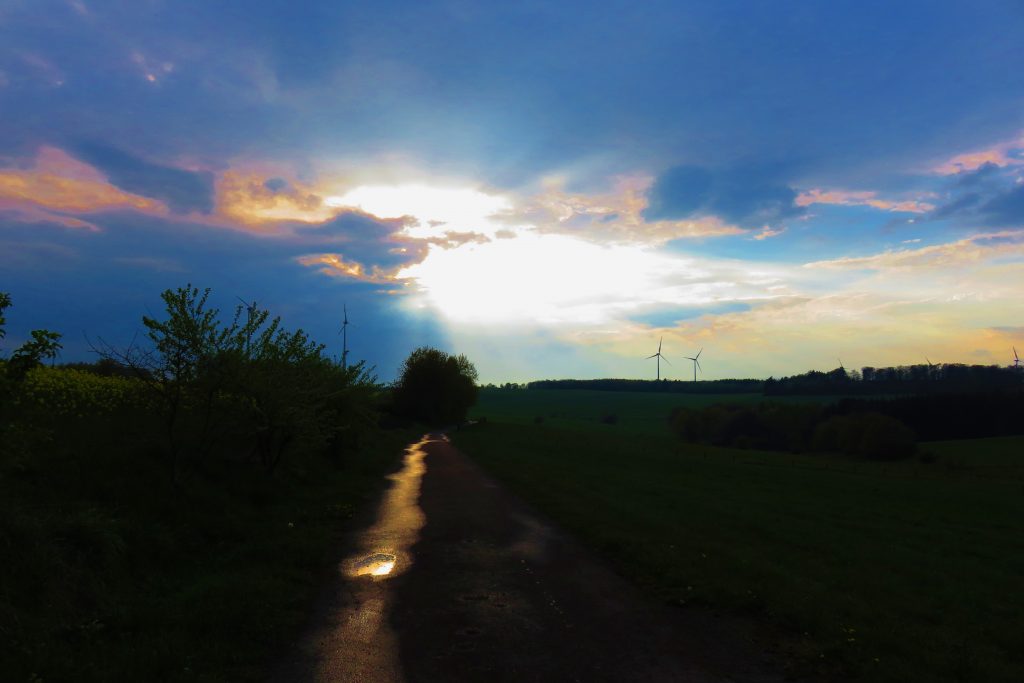
For outdoor enthusiasts who find the rolling hills, mossy forests and creeks to be gently beautiful, for the bicyclist or walker celebrating the gift and solitude of the endless miles of paved virtually-traffic-free country roads – Rheinland-Pfalz is a treasure. If you crave ‘serious’ mountains and breathtaking scenery, go to the Bernese Oberland in Switzerland. Here in Rheinland-Pfalz, the scenery is a more subtle beauty, gentle and serene. The babbling creeks, the meandering river, the peaceful weilers and hofs invite us to explore what is down that green road, over that rise, across the rolling hills.
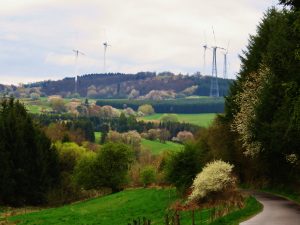
“Across the rolling hills I come riding,
Across the rolling hills, I ramble at my will
Across the rolling hills, I come riding
With my banner in the wind, I come riding …
I sing a song of freedom when I’m riding
I sing a song of freedom for every living being …
On my wind-horse at sunrise, I come riding
On my wind-horse as sunrise, we’re dancing in the sky
Across the rolling hills, I come riding.”
~from Across the Rolling Hills,
song lyrics and music by Peter Rowan
https://www.youtube.com/watch?v=lR4KHHLzfFw
Dr. Mike Bowers
Baumholder, Germany
November 2017
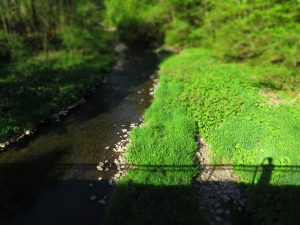
Self-portrait taken from the bridge
over the Nahe River at Schleifműhl,
the heart of the Nahe Timewarp
All photos © drmikebowers.guide@gmail.com
[contact-form][contact-field label=”Name” type=”name” required=”true” /][contact-field label=”Email” type=”email” required=”true” /][contact-field label=”Website” type=”url” /][contact-field label=”Message” type=”textarea” /][/contact-form]
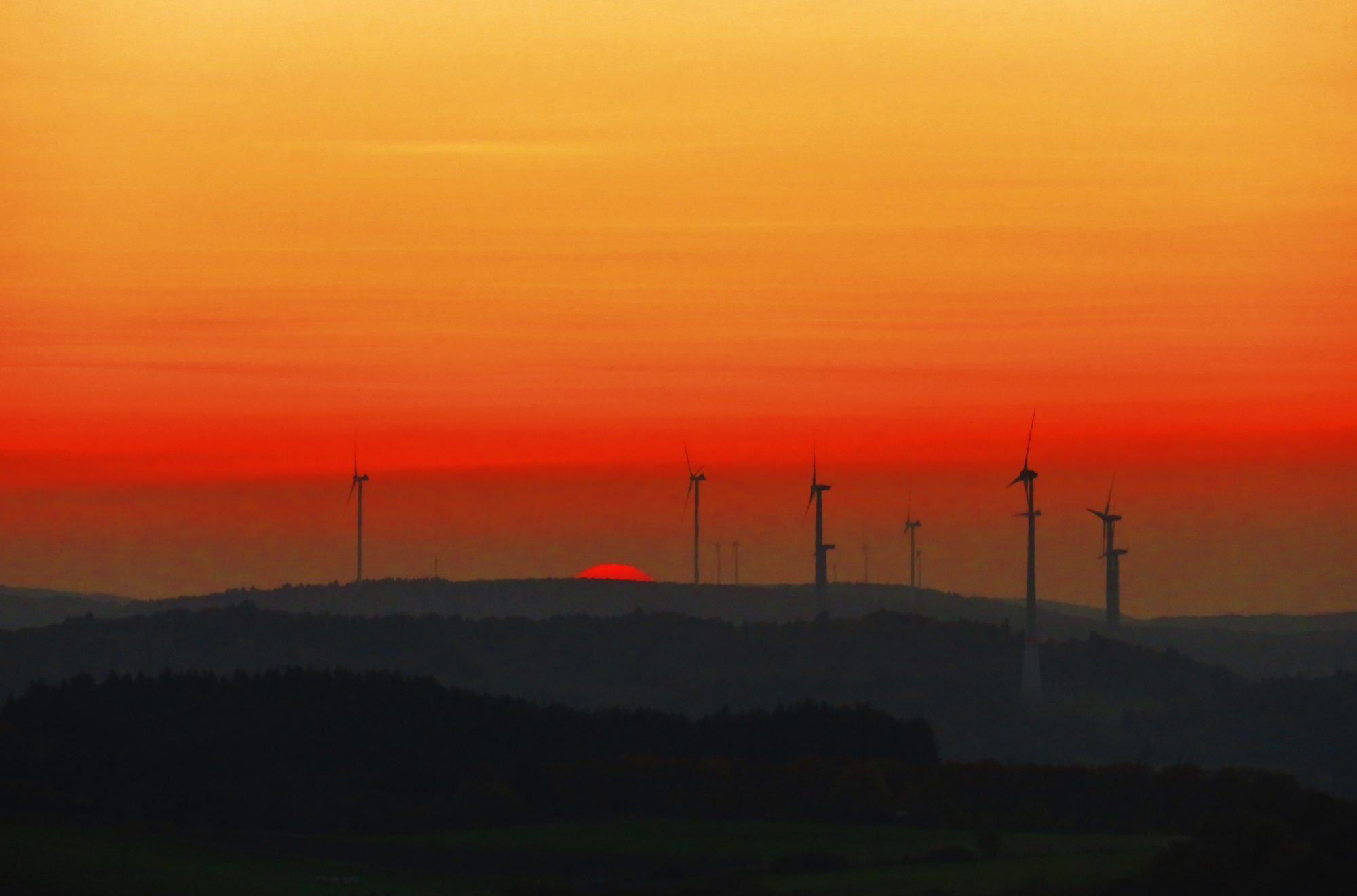
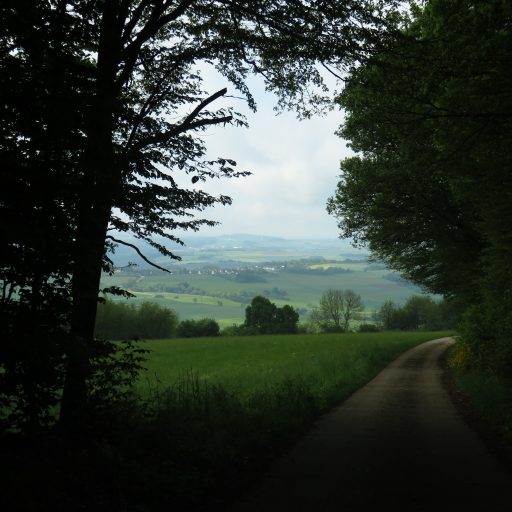
Hmm is anyone else experiencing problems with the pictures on this
blog loading? I’m trying to determine if its a problem on my end or if it’s the blog.
Any suggestions would be greatly appreciated.
It appears that sometimes not all the photos open if the internet speed is low. I will soon begin to provide a link for all the photos in my posts to a GooglePhotos gallery where they can be viewed in full screen. Thank you for checking out the blog. Please check out the latest posts! ~DrMike